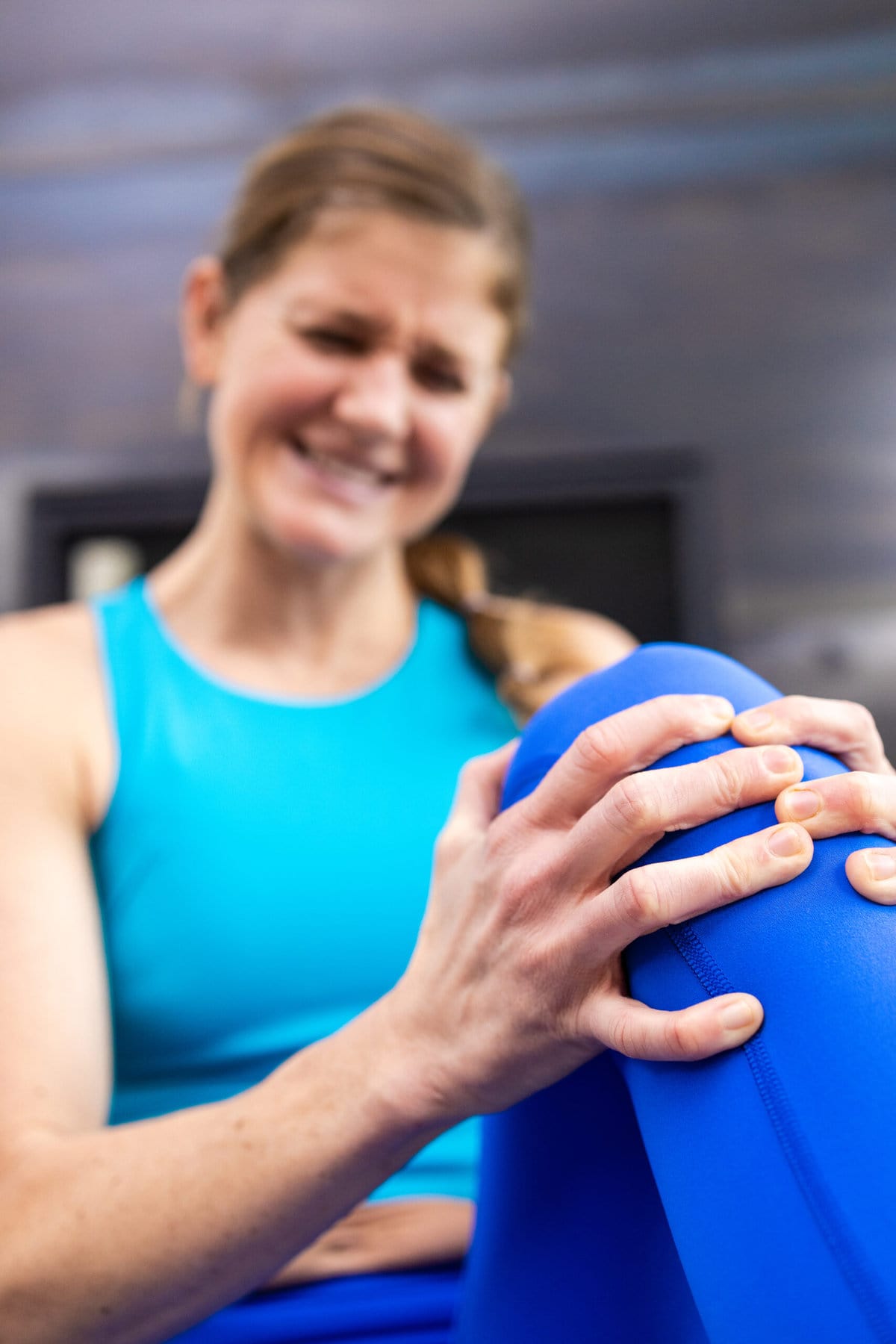Ass-to-grass? Squat to parallel? Partial squats? There are many ways to squat, and many people swear that theirs is right. It can get confusing, so we’re writing this article to help clarify things. More importantly, we will show you how you can use different ranges of motion to improve your squat game. We will get right into it and see how these different ranges of motion differ.
The Proper Range Of Motion For The Squat
Let’s first discuss the proper range of squats. Right off the bat, we have a problem, as the “proper range of motion” will vary depending on who you ask. Regardless, we’ll do our best to answer this while addressing the nuance.
The back squat begins with the body standing fully erect with the hips and soft knees (extended but not locked out). From here, the lifter will descend down while they push their hips back and their knees flex.
From here, they can squat to various depths, either on purpose or not. You’ll find that people can use different terms in studies and general talk. Therefore, we’ll go over the three primary depths and how we’ll define them.

Parallel Squats Or Just Below Parallel Squats
Now, there are many joints involved, so we will determine the depth by the top of the thigh. At the bare minimum, the lifter will continue down until it reaches “parallel” or “just below parallel,” which is when the top of the thigh is parallel with the ground.
At this point, the knee joint is at a 125-degree angle. If this is confusing (Isn’t it 90 degrees!?), note that the angle isn’t measured on the outside of the joint but on the inside, behind the knee.¹
Regardless, a parallel squat is the bare minimum for your squat and is generally the standard.
This also happens to be the depth at which powerlifters are judged during their squat. That said, most people will still squat below parallel or “slightly below” parallel. Therefore, the most common squat depth in the gym is usually below parallel but relatively the same.
ATG Squats (Ass To Grass Squats)
The other range of motion option commonly discussed is the elegantly called “Ass-to-grass,” or ATG for short. ATG squats refer to going down into a full squat—basically as far down as you can go. At this point, the knee angle usually hits around 140 degrees.
ATG squats are used extensively in Olympic lifting and sports such as CrossFit. However, the general public also uses them in the gym.
Half Squats Or Partial Squats
The terms half squats or partial squats are used interchangeably but can refer to different ranges of motion. When we say a half squat, we’re generally referring to when a lifter comes down and where their knee hits 90 degrees. Again, this refers to the back of the knee, which is basically halfway to parallel.
The term partial rep could refer to this, or it could refer to a partial rep, meaning you only perform the bottom half of a rep or the top half. Therefore, we will indicate what we are talking about.
Benefits Of Squats To Parallel Or Just Below Parallel
We’re now going to look at these different depths in a little bit more detail. Specifically, we’ll look at the different benefits each one could bring or drawbacks.
Squat More Weight
The first major benefit of using this range of motion for your squat is that you can move more weight. The lower you go, the harder the squat becomes, making it difficult to move more weight. If your focus is lifting the most weight, you want to make the exercise as easy as possible.
Using a range of motion where you just hit parallel will give you the most significant results. This explains why powerlifters can miss a squat by not hitting depth as they try to hit the minimum depth to lift more weight.
Focus On Your Glutes & Hamstrings
The back squat trains virtually every single muscle in the lower body. This includes the:
These muscles can vary in activation depending on the range of motion. The deeper you go, your quads see greater ROM and flexion at the joints. Therefore, to focus on your hip extensors, the glutes, and hamstrings, stopping at just below parallel will cause greater activation and target these muscles than the quads.²
To be clear, squatting ATG also utilizes greater hip flexion. However, it seems the difference in activation is greater in parallel. That said, studies aren’t always conclusive on whether this results in more significant muscle growth.

Benefits Of ATG Squats
ATG squats can cause quite a commotion when discussing squat depth. Oooooh, the controversy! Here’s the deal: ATG squats are 100% safe, assuming you have the mobility and strength to build up progressively.
Greater Growth Of The Quadriceps
One great benefit of ATG squats is that they provide better quadriceps growth. ATG squats require much greater knee flexion and extension; since the quadriceps are the primary extensor, you’ll get better quad development!³
Further, greater flexion will stretch the quads more. One of the latest discoveries in bodybuilding is lengthened-stretch-mediated hypertrophy. This simply refers to when a muscle sees more growth when it’s stretched to a greater degree.
Improve Mobility & Flexibility
Many people confuse resistance training with mitigating their flexibility. In reality, the exact opposite is true. Performing weighted movements with a full range of motion will improve your body’s mobility and flexibility! When it comes to ATG squats, they take you through a huge ROM!
ATG squats demand that you have excellent flexibility and mobility. In fact, most people in the gym don’t perform ATG squats simply because they can’t! Well, the good thing is that if you start to incorporate ATG squats in your routine, even with lightweight, you’re going to improve the mobility of:
Hips
Knees
Ankles
Even your spine and upper back!
Now, if you already have mobility, continuing to perform ATG squats will guarantee that you will keep it! Mobility and flexibility are just like muscles, and we can lose them!
ATG squats are so effective at improving mobility that they can become part of your mobility routine, assuming you’re using lightweight equipment!
Improve Squat Performance
The deeper you go, the harder it is to maintain good form. This goes hand-in-hand with the above about mobility. A deeper squat requires your form to be on point, as you can’t be off balance. Therefore, the ATG squat will theoretically improve your ability to squat.
This is why it’s a good idea to always keep the ATG squat in your rotation. This may mean you only use it during the warm-ups, which would likely be sufficient for these mobility benefits.
Using Partial Squats With Small Range Of Motion
Another option is to use partial squats, which we’ll call going to a 90-degree flexion above parallel.
Partial Squats Above Parallel
One of the more common issues with the partial squat is that studies show the most significant amount of stress is placed on the knee at 90 degrees. This has led to greater sensations of pain and discomfort.
We don’t want to “scaremonger” and say don’t because we believe the body is highly adaptive and can be trained to handle these stresses. Further, we can consider that many natural movements are performed at 90 degrees, such as jumping (no one squats down to parallel) and sprinting. Also, consider that the deadlift essentially uses the form of a partial squat, and people are moving a lot of weight; we’ll touch on this below.
At the same time, we’re not really getting any benefits you would receive from this, at least for the general public. Now, an argument could be made that you could lift supramaximal loads, which could possibly be a tactic for advanced lifters and powerlifters.
Sometimes, a powerlifter will perform a squat from pins and may start above parallel. You start the movement with the concentric and simply press the bar into full extension. This may not be an issue because it removes the eccentric and switches to the concentric. It’s believed that the transition from eccentric to concentric causes issues for people, and a pin press takes this away.
For the general public, we can’t give any reason to perform these apart from someone having mobility issues. If this is you, you’d probably be better off working on full squats with a light load and using the leg press to load the legs.
Partial Squats Below Parallel
Now, let’s talk about partial squats, but in the other direction, below parallel. As we discussed above with ATG squats, the bottom portion of the squat lengthens the muscle, which has been shown to be superior for muscle growth.⁵
To take advantage of this, you could use pulse squats, also known as 1 ¼ squats. A pulse squat has you first descend into a full squat below parallel, ideally ATG. You then ascend to parallel but reverse and go back down into ATG. You then push up into full extension.
This increases the time you spend in the lengthened position. We can figure that we only have so much energy before we fatigue. During a regular squat, a single rep would have you split that energy to a 1:1 ratio between the shortened and lengthened positions. With a pulse squat, you achieve a 2:1, meaning you are in the lengthened position twice as much.
We don’t have any studies looking at pulse squats, but this could theoretically be an effective method to increase muscle growth. With that said, only those with intermediate status should use this method and treat it like a new lift. By that, we mean to use a lighter load and then progressively use heavier weight just to see how your body responds.

What Range Of Motion For Squat Should You Use?
Now that we have reviewed some of the differences and possible benefits, we need to look at the big picture. Many proposed benefits above are theoretical and don’t always play out in real life. This is likely due to the fact that people have different-length limbs, resulting in different mechanics.
For example, a 2019 study looked at full squats and half squats to 90 degrees. While the full squat did elicit greater growth in the glutes (6% vs. 2%), muscle growth in the quads was slightly greater in the full squat (4.9% vs. 4.6%).⁴ We would have theoretically expected greater results with the greater ROM in the knee.
All this means is that none of what we have said will apply 100% of the time to every situation. They are theoretical in nature and while there may have evidence to back up their suggestion, it does not mean it will yield the same results in every person.
Proper range of motion is likely to depend on you, your needs, and your mobility. Here are some variables that could dictate what you use.
For Mobility
Remember that mobility is the primary indicator that you can perform deeper squats. If you don’t have mobility to perform ATG squats, then this isn’t really a question you need to worry about.
Use the depth you can perform. You could then increase your squat depth using bodyweight squats or alternatives.
For Performance Needs
Performance needs are another variable. For some, just below parallel is specific to their sport, so this should be the primary depth at which you squat. For others, ATG may be optimal as their needs require a greater range of motion. Or perhaps their personal needs simply require strengthening the joints and muscles in an extreme ROM.
Consider Your Program Needs
One other aspect is to look at the other lifts in your program. Are you already using a movement with high levels of knee flexion, something like the front squat? If so, it mitigates the need to use the ATG squat. However, if the back squat is your only primary compound squatting movement, ATG could provide that variation.
Summary Of How To Use Different Range Of Motion With Squats
Due to all the variables, using a different range of motion with squats can be a bit nuanced. With that said, here’s a brief summary of how you can use a different range of motions to optimize your training.
Parallel or Just Below: This is the go-to range of motion and the place most people can start at. Use it if you want the general strength and mass that the squat is known for.
ATG: ATG is a really good option for lifters concerned with performance and mobility. Although you may not press as much weight, you get a perfect stretch and keep your joints healthy.
Partial (Top Half): The partial rep (top half) should only be used by more advanced lifters explicitly looking to increase absolute squat numbers. If you want to use these, experiment with pin presses starting at just below 90 degrees.
Partial (Bottom Half): The partial rep (bottom half) has been researched to support its use for muscle growth. Using it as a drop set could be interesting if you wanted to experiment. After your standard set, drop the load by 30% or so and perform pulse squats until failure. You could also experiment with 1 ¼ reps.
Now you know the best ROM for squats, it’s time to learn about bench press ROM techniques for more gains!
References
Cotter, Joshua A., et al. “Knee Joint Kinetics in Relation to Commonly Prescribed Squat Loads and Depths.” Journal of Strength and Conditioning Research, vol. 27, no. 7, July 2013, pp. 1765–1774, www.ncbi.nlm.nih.gov/pmc/articles/PMC4064719/, Accessed 30 Nov. 2019.
da Silva, Josinaldo J., et al. “Muscle Activation Differs between Partial and Full Back Squat Exercise with External Load Equated.” Journal of Strength and Conditioning Research, vol. 31, no. 6, June 2017, pp. 1688–1693,
Bloomquist, K., et al. “Effect of Range of Motion in Heavy Load Squatting on Muscle and Tendon Adaptations.” European Journal of Applied Physiology, vol. 113, no. 8, 20 Apr. 2013, pp. 2133–2142, link.springer.com/article/10.1007%2Fs00421-013-2642-7, Accessed 14 Oct. 2019.
Cotter, Joshua A., et al. “Knee Joint Kinetics in Relation to Commonly Prescribed Squat Loads and Depths.” Journal of Strength and Conditioning Research, vol. 27, no. 7, July 2013, pp. 1765–1774, www.ncbi.nlm.nih.gov/pmc/articles/PMC4064719/, Accessed 30 Nov. 2019.
Pedrosa, Gustavo F., et al. “Partial Range of Motion Training Elicits Favorable Improvements in Muscular Adaptations When Carried out at Long Muscle Lengths.” European Journal of Sport Science, vol. 22, no. 8, 23 May 2021, pp. 1250–1260, pubmed.ncbi.nlm.nih.gov/33977835/,







